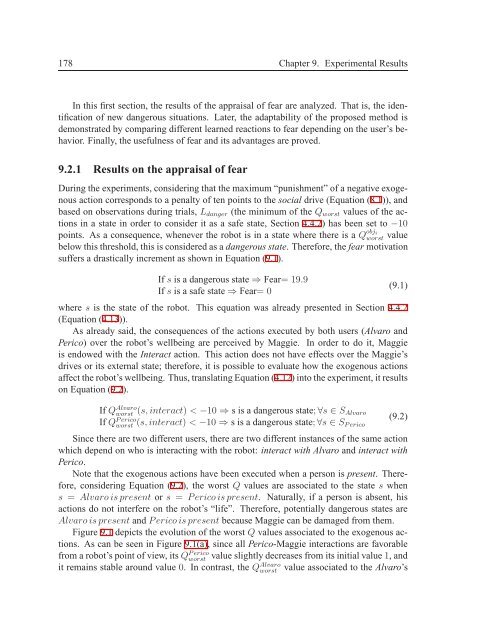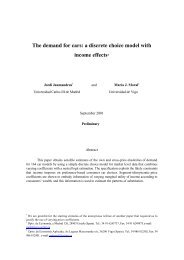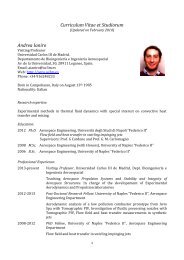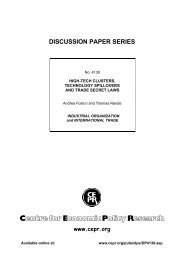TESIS DOCTORAL - Robotics Lab - Universidad Carlos III de Madrid
TESIS DOCTORAL - Robotics Lab - Universidad Carlos III de Madrid
TESIS DOCTORAL - Robotics Lab - Universidad Carlos III de Madrid
Create successful ePaper yourself
Turn your PDF publications into a flip-book with our unique Google optimized e-Paper software.
178 Chapter 9. Experimental ResultsIn this first section, the results of the appraisal of fear are analyzed. That is, the i<strong>de</strong>ntificationof new dangerous situations. Later, the adaptability of the proposed method is<strong>de</strong>monstrated by comparing different learned reactions to fear <strong>de</strong>pending on the user’s behavior.Finally, the usefulness of fear and its advantages are proved.9.2.1 Results on the appraisal of fearDuring the experiments, consi<strong>de</strong>ring that the maximum “punishment” of a negative exogenousaction corresponds to a penalty of ten points to the social drive (Equation (8.1)), andbased on observations during trials, L danger (the minimum of the Q worst values of the actionsin a state in or<strong>de</strong>r to consi<strong>de</strong>r it as a safe state, Section 4.4.2) has been set to −10points. As a consequence, whenever the robot is in a state where there is a Q obj iworst valuebelow this threshold, this is consi<strong>de</strong>red as a dangerous state. Therefore, the fear motivationsuffers a drastically increment as shown in Equation (9.1).If s is a dangerous state ⇒ Fear= 19.9If s is a safe state ⇒ Fear= 0(9.1)where s is the state of the robot. This equation was already presented in Section 4.4.2(Equation (4.13)).As already said, the consequences of the actions executed by both users (Alvaro andPerico) over the robot’s wellbeing are perceived by Maggie. In or<strong>de</strong>r to do it, Maggieis endowed with the Interact action. This action does not have effects over the Maggie’sdrives or its external state; therefore, it is possible to evaluate how the exogenous actionsaffect the robot’s wellbeing. Thus, translating Equation (4.12) into the experiment, it resultson Equation (9.2).If Q Alvaroworst (s, interact) < −10 ⇒ s is a dangerous state; ∀s ∈ S AlvaroIf Q Perico(9.2)worst (s, interact) < −10 ⇒ s is a dangerous state; ∀s ∈ S PericoSince there are two different users, there are two different instances of the same actionwhich <strong>de</strong>pend on who is interacting with the robot: interact with Alvaro and interact withPerico.Note that the exogenous actions have been executed when a person is present. Therefore,consi<strong>de</strong>ring Equation (9.2), the worst Q values are associated to the state s whens = Alvaro is present or s = Perico is present. Naturally, if a person is absent, hisactions do not interfere on the robot’s “life”. Therefore, potentially dangerous states areAlvaro is present and Perico is present because Maggie can be damaged from them.Figure 9.1 <strong>de</strong>picts the evolution of the worst Q values associated to the exogenous actions.As can be seen in Figure 9.1(a), since all Perico-Maggie interactions are favorablefrom a robot’s point of view, its Q Pericoworst value slightly <strong>de</strong>creases from its initial value 1, andit remains stable around value 0. In contrast, the Q Alvaroworst value associated to the Alvaro’s






